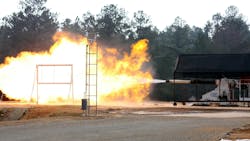A Partnership in Defense Engineering
A collaboration between Element U.S. Space and Defense and Texas Tech University’s Mechanical Engineering department represents the potential for groundbreaking advancements in defense technology. Dr. John Granier, chief engineer of munitions and energetics at Element, and Dr. Michelle Pantoya from Texas Tech Combustion Lab, spoke with Machine Design about how understanding the ignition processes in a range of ammunition systems—from small arms to large tank rounds—will help improve the performance and safety of munitions.
The partnership between Element and Texas Tech is rooted in a shared commitment to address national security challenges. Pantoya sees the importance of integrating the expertise of seasoned professionals with the energy and creativity of students—a collaboration that not only improves the educational experience for graduate students but also bridges the gap between theoretical research and practical applications.
From Propellant Ignition to Advanced Diagnostics
One prominent project stemming from this partnership involves the study of propellant ignition processes. By focusing on the early heat transfer mechanisms during ignition—an essential aspect in the functionality of various military systems—the team aims to develop more reliable and efficient propellants.
The collaboration allows them to explore innovative methodologies for quantifying energy conversion processes, which are necessary for optimizing propellant formulations. These advancements not only offer improvements in performance metrics—including velocity, range and accuracy of weapon systems—but also improve safety by identifying conditions that could lead to failures.
The Role of Advanced Technologies
A part of their research uses sensor technologies designed to capture critical data in real time. One of the breakthrough methodologies they use is digital tomography, which utilizes high-speed cameras equipped with filters and software to analyze temperature distribution. This approach allows researchers to visualize and quantify temperature changes in the ignition process that occur at incredibly rapid timescales.
These sensors can capture data at rates of up to 200,000 frames per second, providing temporal and spatial resolutions. This allows for a deep understanding of the energy dynamics during ignition, shedding light on how heat transfers between gases, solids and other phases in a confined system.
The use of filtered light emission analysis facilitates the extraction of temperature data based on Planck’s law of black body radiation, Pantoya explained. This method involves collecting multiple intensity measurements at discrete wavelengths, enabling precise quantification of thermal emissions. Consequently, this provides insights into the energy transfer mechanisms within the combustion environment, which is important for optimizing propellant formulations.
Emerging technologies like artificial intelligence (AI), robotics and advanced materials are also a part of the partnership’s efforts. While current projects focus on fundamental research using state-of-the-art diagnostics, the data generated will ultimately serve as a foundation for future AI and machine learning applications.
As both Granier and Pantoya point out, the high-speed cameras employed in their experiments allow for unprecedented data capture at varying temperatures and conditions. This capability significantly enriches the datasets necessary for developing predictive models that can influence future material development.
Additive Manufacturing Allows for New Geometries
The research team employs additive manufacturing (AM) techniques to rapidly prototype components tailored to their specific experimental needs, helping to accelerate the design process and increase the precision of their studies.
AM allows for the creation of geometries previously unattainable using traditional methods, which can improve the performance of propellants through optimized designs. Granier says this technology enables rapid prototyping and iteration, accelerating the timeline from concept to deployment.
Pantoya echoes this sentiment, noting that the ability to quickly produce tailored components can greatly enhance experimental design. “In academic environments, additive manufacturing is essential for swiftly adjusting our experimental apparatus to meet specific needs,” she said.
Overcoming Engineering Challenges
The journey from design to prototype includes several challenges. Both Granier and Pantoya acknowledged that iterative design is necessary to address the complexities of their experiments. Every trial yields new insights, leading to refinements and experimental setups, which are necessary to uncover the underlying physics of combustion and propulsion systems.
A significant aspect of their work lies in isolating variables during experiments to better understand how different materials and geometries affect propellant performance. Testing protocols at element are stringent, particularly due to the unique nature of defense products where each prototype often represents a one-of-a-kind asset. Granier explained they must ensure the reliability of results from the outset to minimize risk during critical tests. The timeline is often tight, and they aim to collect valuable data within those constraints, he said.
Future Trends in Defense
Looking ahead, the integration of emerging technologies such as machine learning and advanced visualization techniques promises to further enhance the capabilities of defense applications. This information will enable more sophisticated modeling and predictive analytics in future propellant formulations.
Pantoya reiterates that the data generated from their experiments will contribute to larger datasets that can inform the application of AI in optimizing defense technologies. By breaking down the complexities of combustion physics, they aim to pave the way for innovations that not only meet stringent defense standards, but also improve the overall safety and effectiveness of military operations.
The partnership is not just about technological advancements, it is also about cultivating the next generation of defense engineers. Engaging students in meaningful research contributes to their education while simultaneously addressing defense challenges. By fostering an environment conducive to collaboration, knowledge sharing and mentorship, this alliance not only prepares students for careers in defense engineering, but also plays a role in developing the advanced solutions necessary to meet the future challenges of national security.
Be sure to check out our five-part interview series with Dr. John Granier and Dr. Michelle Pantoya:
Part 1: Forging the Future of Defense with Modern Methodologies
Part 2: The Role of Advanced Sensors in Propellant Technology
Part 3: Prototyping Solutions for the Defense Industry
Part 4: Assessing Effectiveness and Reliability in Prototype Development
Part 5: The Future of Defense Engineering: Trends and Insights
Editor’s Note: Machine Design’s WISE (Workers in Science and Engineering) hub compiles our coverage of workplace issues affecting the engineering field, in addition to contributions from equity seeking groups and subject matter experts within various subdisciplines.
About the Author
Sharon Spielman
Technical Editor, Machine Design
As Machine Design’s technical editor, Sharon Spielman produces content for the brand’s focus audience—design and multidisciplinary engineers. Her beat includes 3D printing/CAD; mechanical and motion systems, with an emphasis on pneumatics and linear motion; automation; robotics; and CNC machining.
Spielman has more than three decades of experience as a writer and editor for a range of B2B brands, including those that cover machine design; electrical design and manufacturing; interconnection technology; food and beverage manufacturing; process heating and cooling; finishing; and package converting.
Email: [email protected]
LinkedIn: @sharonspielman
Facebook: Machine Design
YouTube: @MachineDesign-EBM




